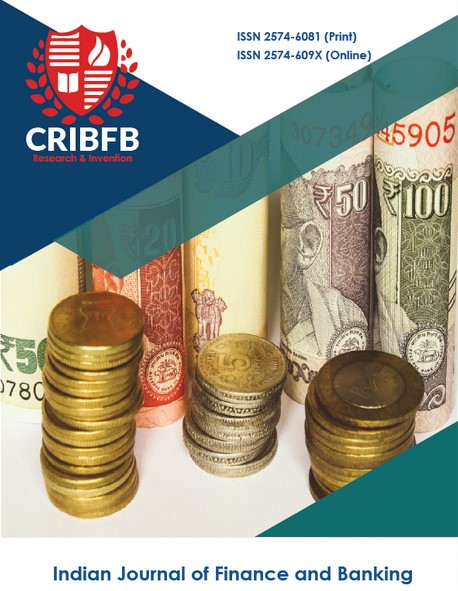Liquidity and Asset Pricing: Evidence from Indian Stock Market
Main Article Content
Abstract
In this research article, we present a liquidity premium based asset pricing model and test it in the Indian stock market. Using high-frequency data of stocks listed in the National Stock Exchange, we show that observed illiquidity has a significant negative impact on realized stock returns even after controlling for the up and down market, volatility, and effects of derivatives trading. The illiquidity measure is modified for its time variations, and then the modified measure is used to assess its impact on returns. Using a cross-section of stocks, we show the year wise results of the model and extend it to show that it has some role in explaining returns across industries. Findings show that the down market has contemporaneous systematic risk at higher levels, and the market risk premium is higher in down markets. Finance, utility and real estate sector companies have higher systematic risk in both up and down market and investors of these sectors has relatively higher expected higher returns in comparison to companies from the rest of the segments.
JEL Classifications: G10, G12.
Downloads
Article Details
Section
How to Cite
References
Acharya, V. V., & Pedersen, L. H. (2005). Asset pricing with liquidity risk. Journal of financial Economics, 77(2), 375-410.
Ahn, H. J., Cai, J., & Yang, C. W. (2018). Which liquidity proxy measures liquidity best in emerging markets?. Economies, 6(4), 1-29.
Artikis, P. G. (2018). Liquidity as an asset pricing factor in the UK. Journal of Financial Management, Markets and Institutions, 6(2). https://doi.org/10.1142/S2282717X18500081
Amihud, Y. (2002). Illiquidity and stock returns: cross-section and time-series effects. Journal of financial markets, 5(1), 31-56.
Amihud, Y., & Mendelson, H. (1986). Asset pricing and the bid-ask spread. Journal of financial Economics, 17(2), 223-249.
Amihud, Y., Hameed, A., Kang, W., & Zhang, H. (2015). The illiquidity premium: International evidence. Journal of Financial Economics, 117(2), 350-368.
Ang, A., Hodrick, R. J., Xing, Y., & Zhang, X. (2009). High idiosyncratic volatility and low returns: International and further US evidence. Journal of Financial Economics, 91(1), 1-23. https://doi.org/10.1016/J.JFINECO.2007.12.005
Bekaert, G., Harvey, C. R., & Lundblad, C. (2007). Liquidity and expected returns: Lessons from emerging markets. The review of financial studies, 20(6), 1783-1831. https://doi.org/10.1093/rfs/hhm030.
Bhattacharya, S. N., Bhattacharya, M., & Basu, S. (2019). Stock market and its liquidity: Evidence from ARDL bound testing approach in the Indian context. Cogent Economics & Finance, 7(1), 1586297. https://doi.org/10.1080/23322039.2019.1586297
Bhattacharya, S. N., Sengupta, P., Bhattacharya, M., & Roychoudhury, B. (2016). Multidimensional liquidity: Evidences from Indian stock market. Applied Finance Letters, 5(2), 28-44.
Bhuyan, R., & Chaudhury, M. (2005). Trading on the information content of open interest: Evidence from the US equity options market. Derivatives Use, Trading & Regulation, 11(1), 16-36.
Brunnermeier, M. K., & Pedersen, L. H. (2009). Market liquidity and funding liquidity. The review of financial studies, 22(6), 2201-2238.
Chordia, T., Roll, R., & Subrahmanyam, A. (2001a). Market liquidity and trading activity. The journal of finance, 56(2), 501-530.
Chordia, T., Subrahmanyam, A., & Anshuman, V. R. (2001b). Trading activity and expected stock returns. Journal of financial Economics, 59(1), 3-32.
Claessens, S., Kose, M. A., & Terrones, M. E. (2012). How do business and financial cycles interact?. Journal of International economics, 87(1), 178-190.
Datar, V. T., Naik, N. Y., & Radcliffe, R. (1998). Liquidity and stock returns: An alternative test. Journal of Financial Markets, 1(2), 203-219.
Dey, M. K. (2005). Turnover and return in global stock markets. Emerging Markets Review, 6(1), 45-67.
Donadelli, M., & Prosperi, L. (2012). On the role of liquidity in emerging markets stock prices. Research in Economics, 66(4), 320-348.
Easley, D., Hvidkjaer, S., & O'hara, M. (2002). Is information risk a determinant of asset returns?. The journal of finance, 57(5), 2185-2221.
Fama, E. F., & MacBeth, J. D. (1973). Risk, return, and equilibrium: Empirical tests. Journal of political economy, 81(3), 607-636.
Fodor, A., Krieger, K., & Doran, J. S. (2011). Do option open-interest changes foreshadow future equity returns?. Financial markets and portfolio management, 25(3), 265-280.
Garleanu, N., & Pedersen, L. H. (2007). Liquidity and risk management. American Economic Review, 97(2), 193-197.
Garleanu, N., & Pedersen, L. H. (2011). Margin-based asset pricing and deviations from the law of one price. The Review of Financial Studies, 24(6), 1980-2022.
Hameed, A., Kang, W., & Viswanathan, S. (2010). Stock market declines and liquidity. The Journal of finance, 65(1), 257-293.
Hearn, B. (2010). Time varying size and liquidity effects in South Asian equity markets: A study of blue-chip industry stocks. International Review of Financial Analysis, 19(4), 242-257.
Jun, S. G., Marathe, A., & Shawky, H. A. (2003). Liquidity and stock returns in emerging equity markets. Emerging Markets Review, 4(1), 1-24.
Kumar, G., & Misra, A. K. (2019). Liquidity-adjusted CAPM—An empirical analysis on Indian stock market. Cogent Economics & Finance, 7(1), 1573471.
Lee, K. H. (2011). The world price of liquidity risk. Journal of Financial Economics, 99(1), 136-161.
Liang, S. X., & Wei, J. K. (2012). Liquidity risk and stock returns around the world. Journal of Banking & Finance, 36(12), 3274-3288.
Narayan, P. K., & Zheng, X. (2011). The relationship between liquidity and returns on the Chinese stock market. Journal of Asian Economics, 22(3), 259-266.
Ofek, E., & Richardson, M. (2003). Dotcom mania: The rise and fall of internet stock prices. The Journal of Finance, 58(3), 1113-1137.
Pástor, Ľ., & Stambaugh, R. F. (2003). Liquidity risk and expected stock returns. Journal of Political economy, 111(3), 642-685.
Stereńczak, S., Zaremba, A., & Umar, Z. (2020). Is there an illiquidity premium in frontier markets?. Emerging Markets Review, 42, 100673.




